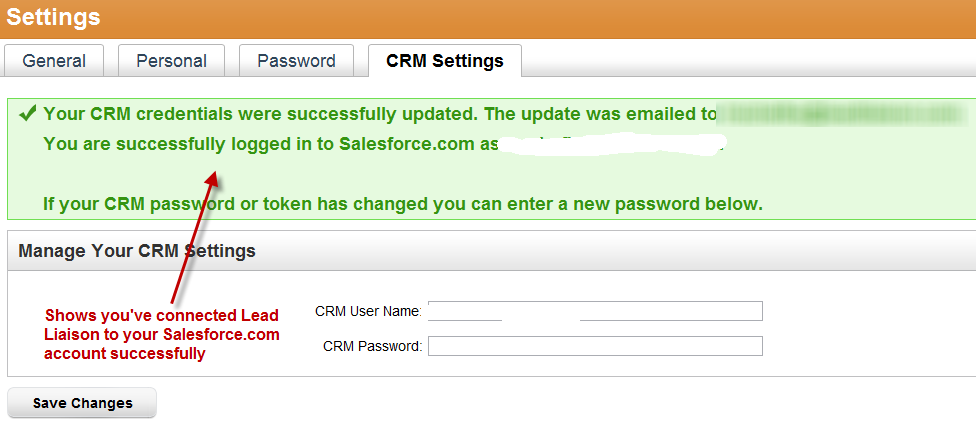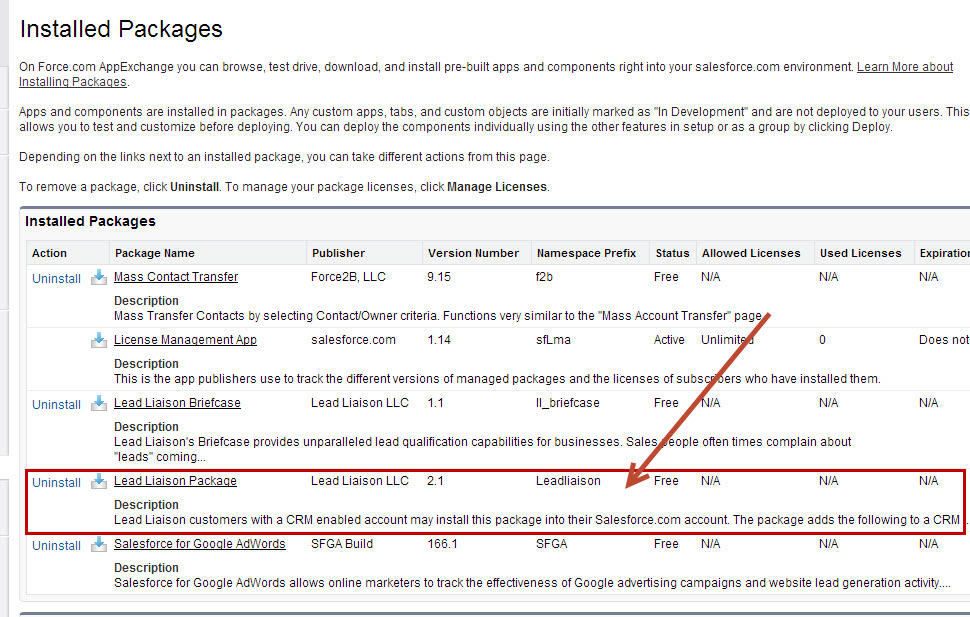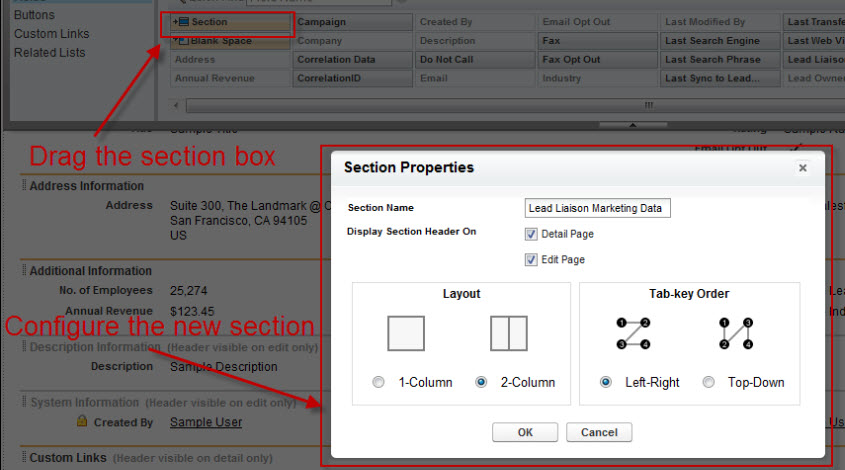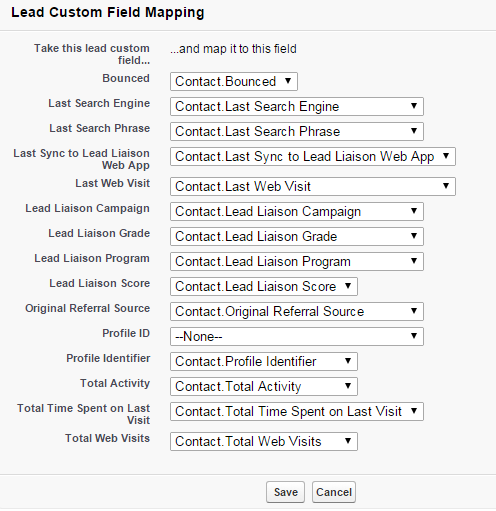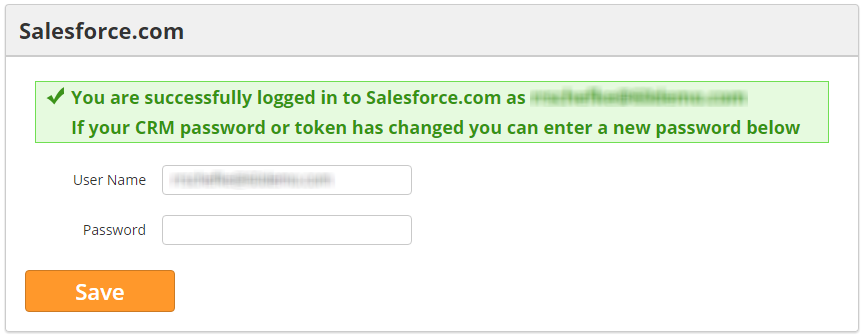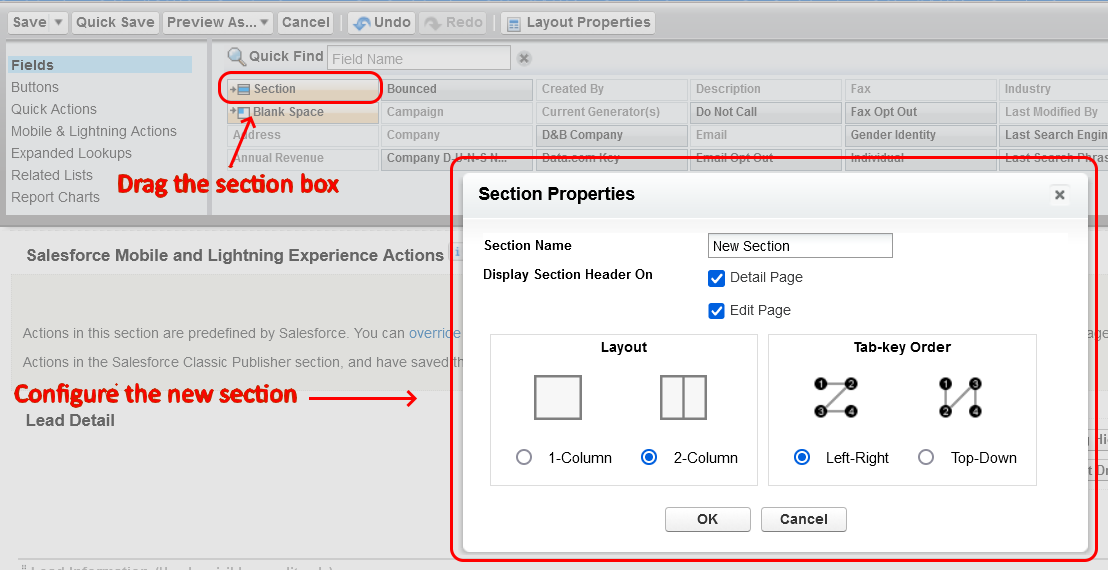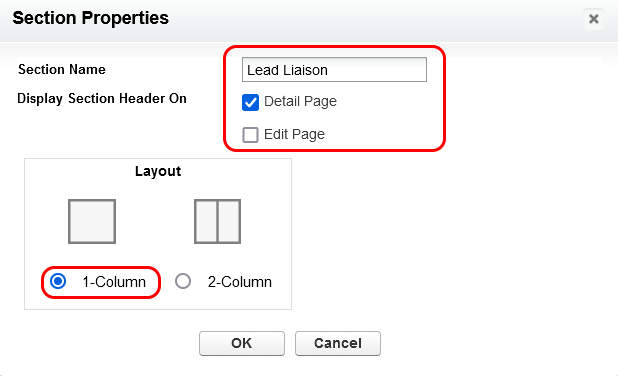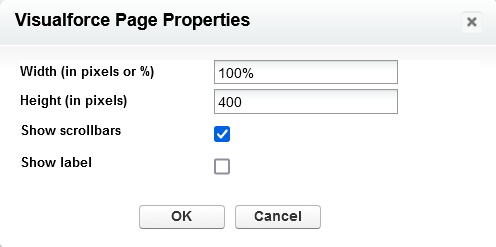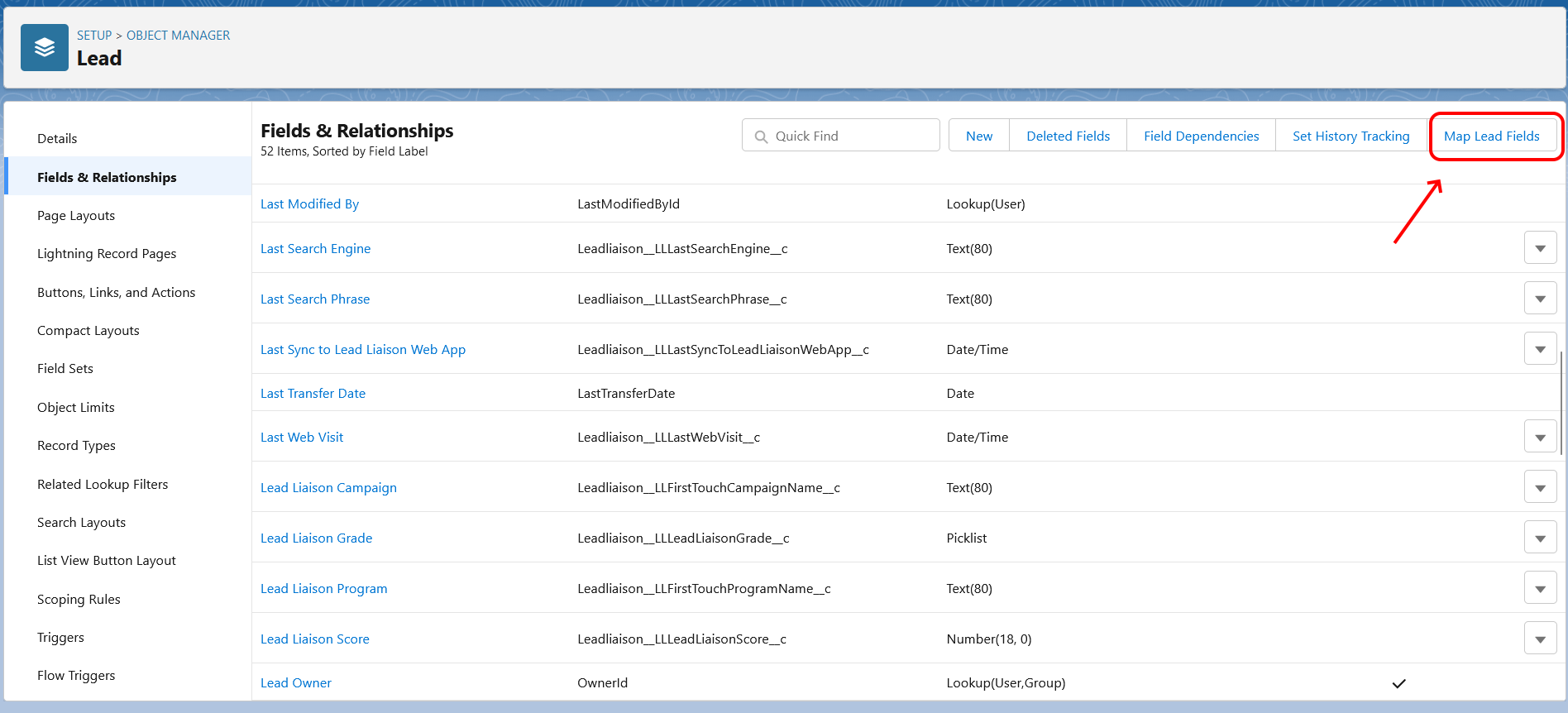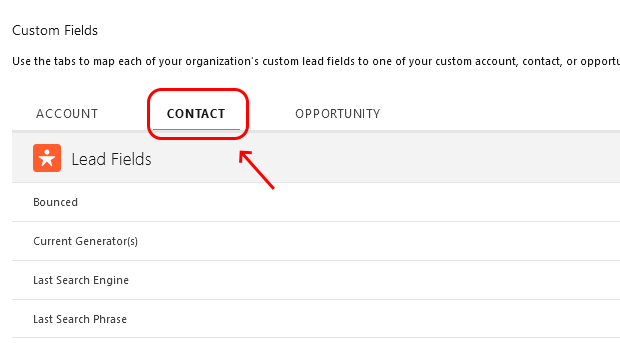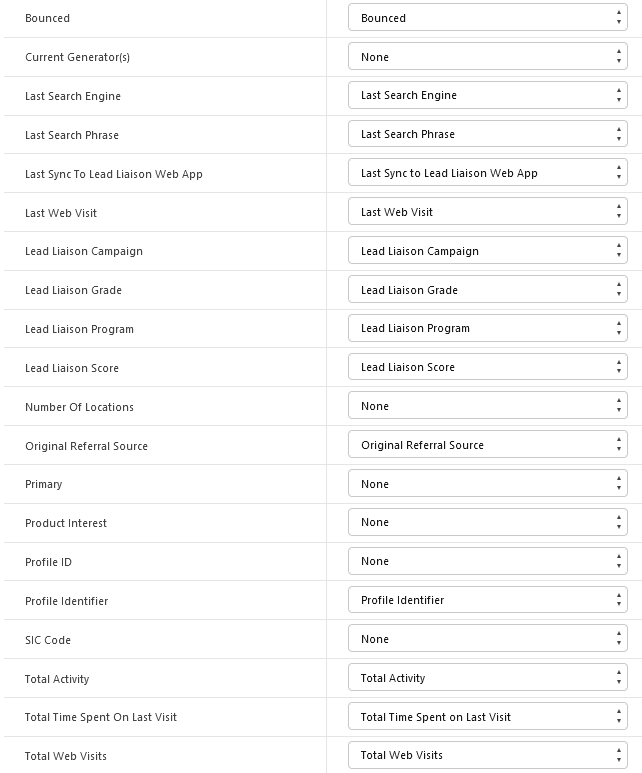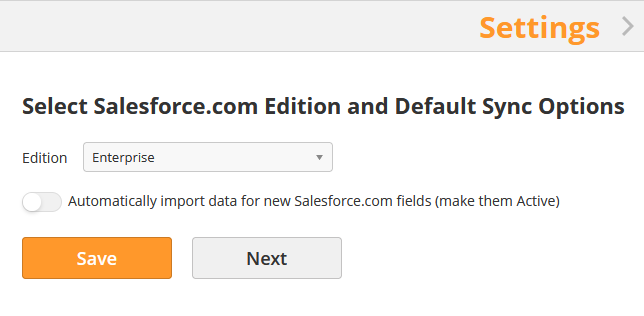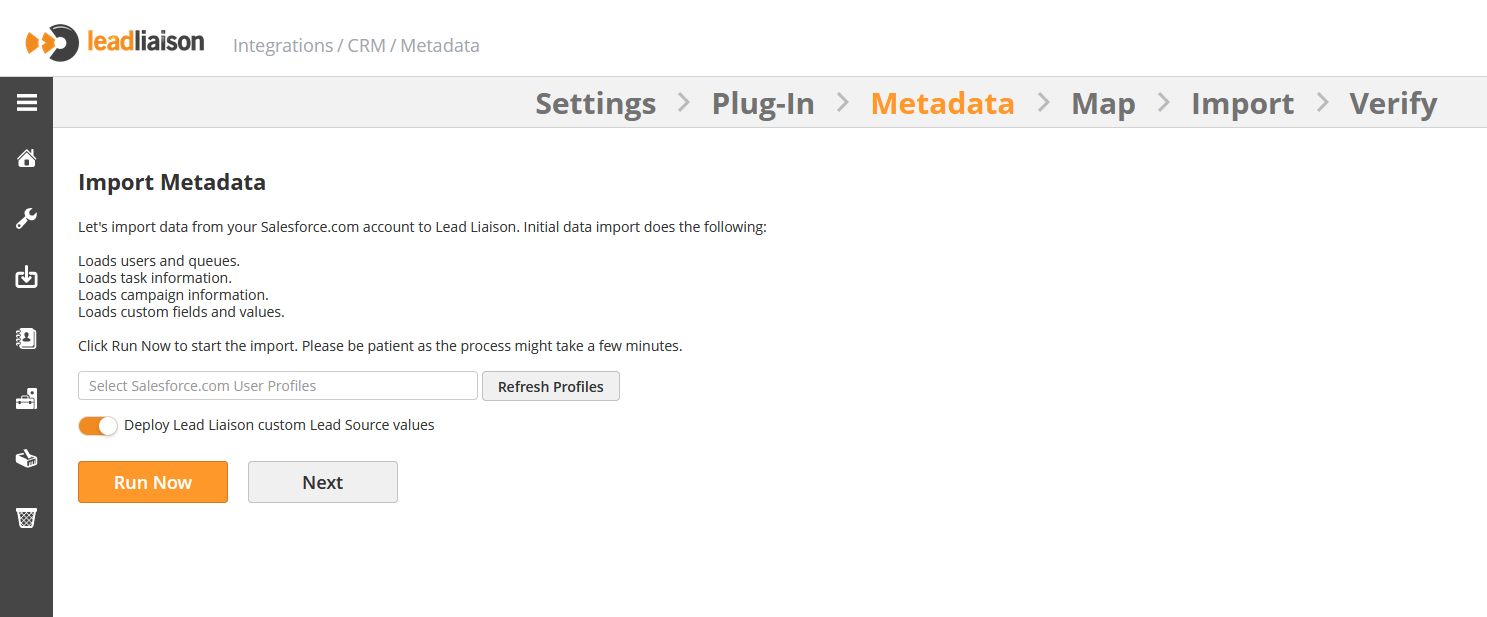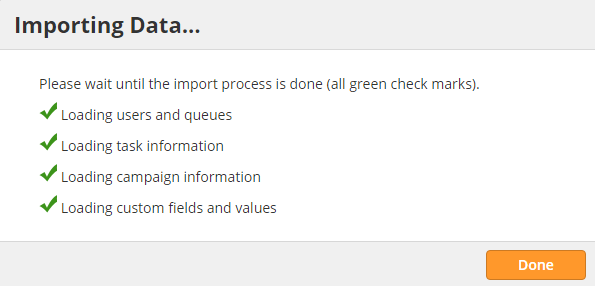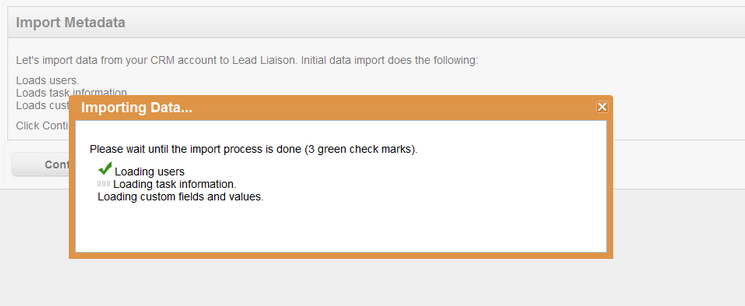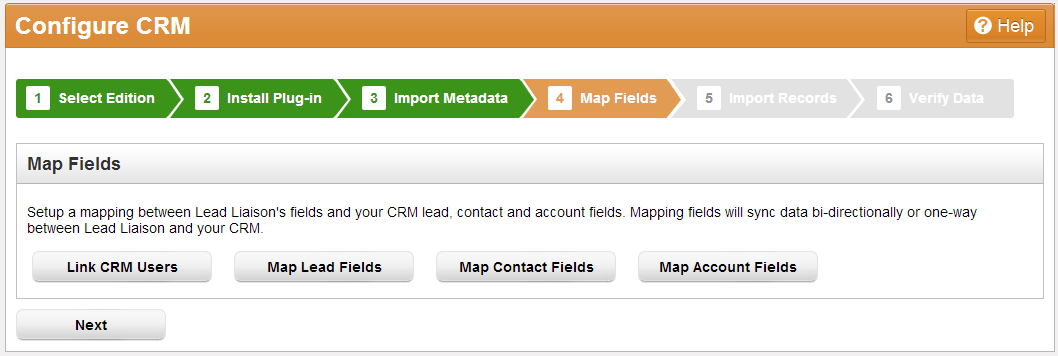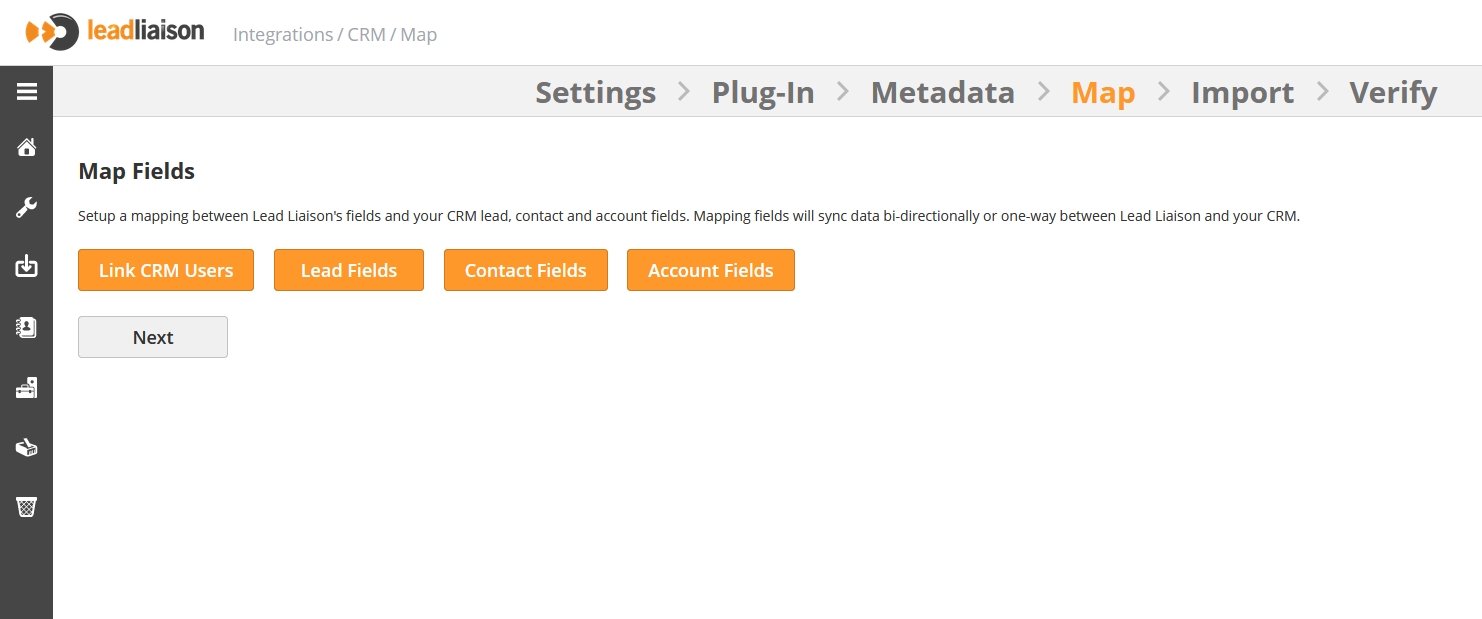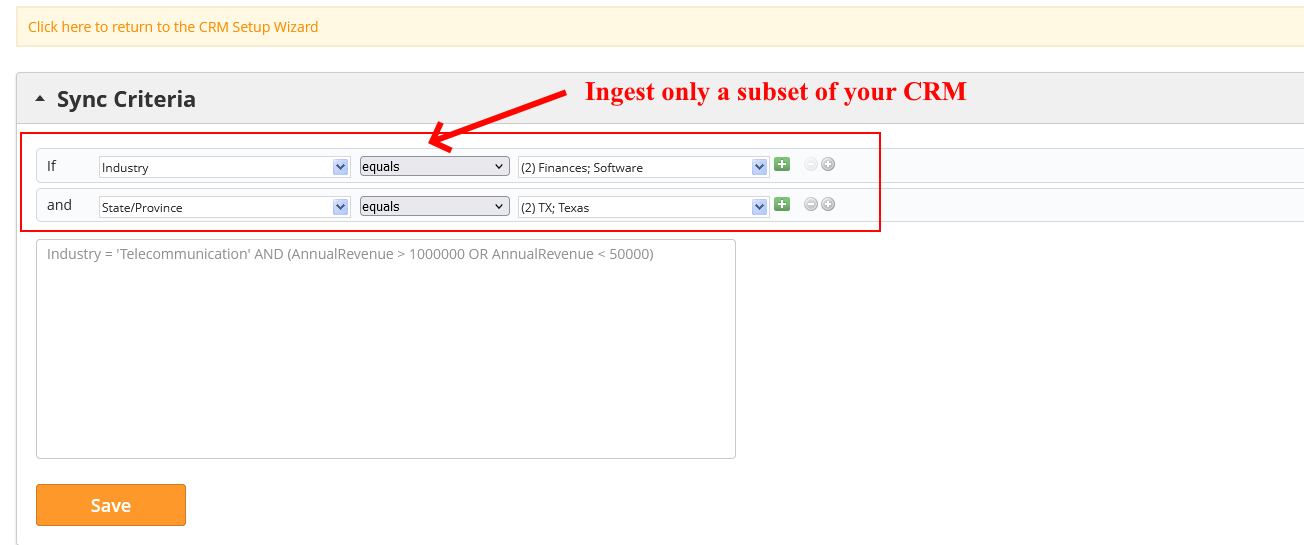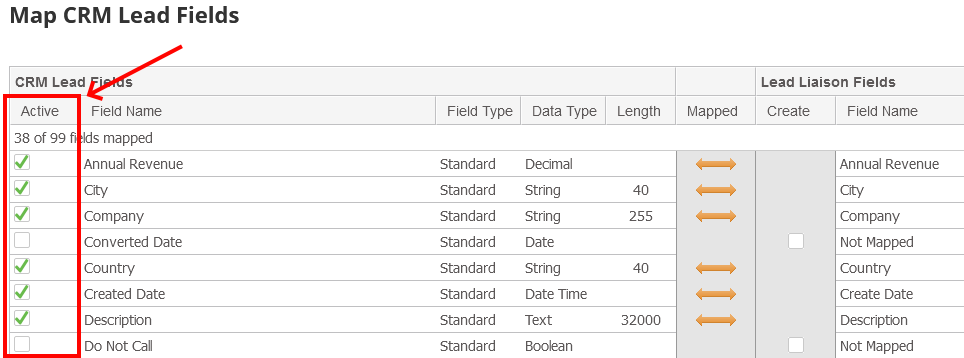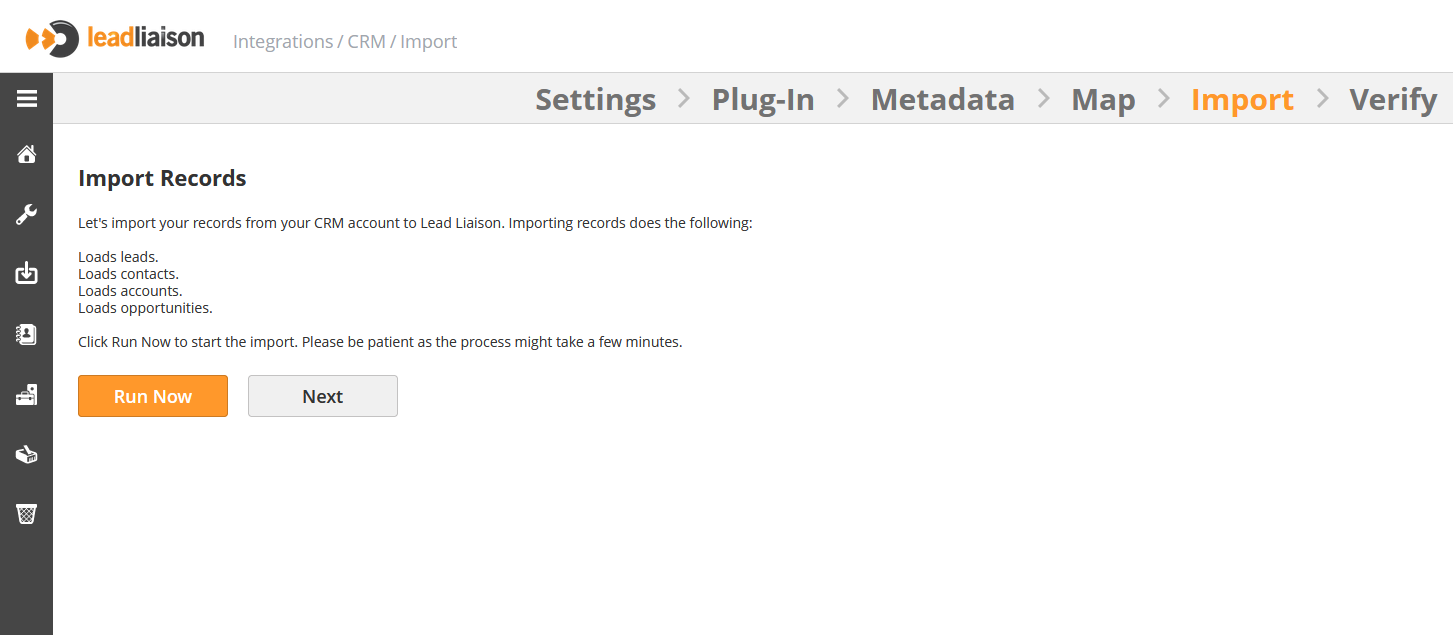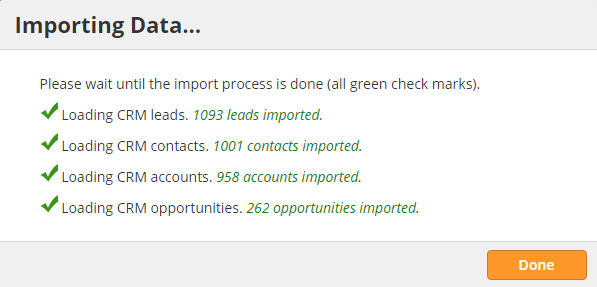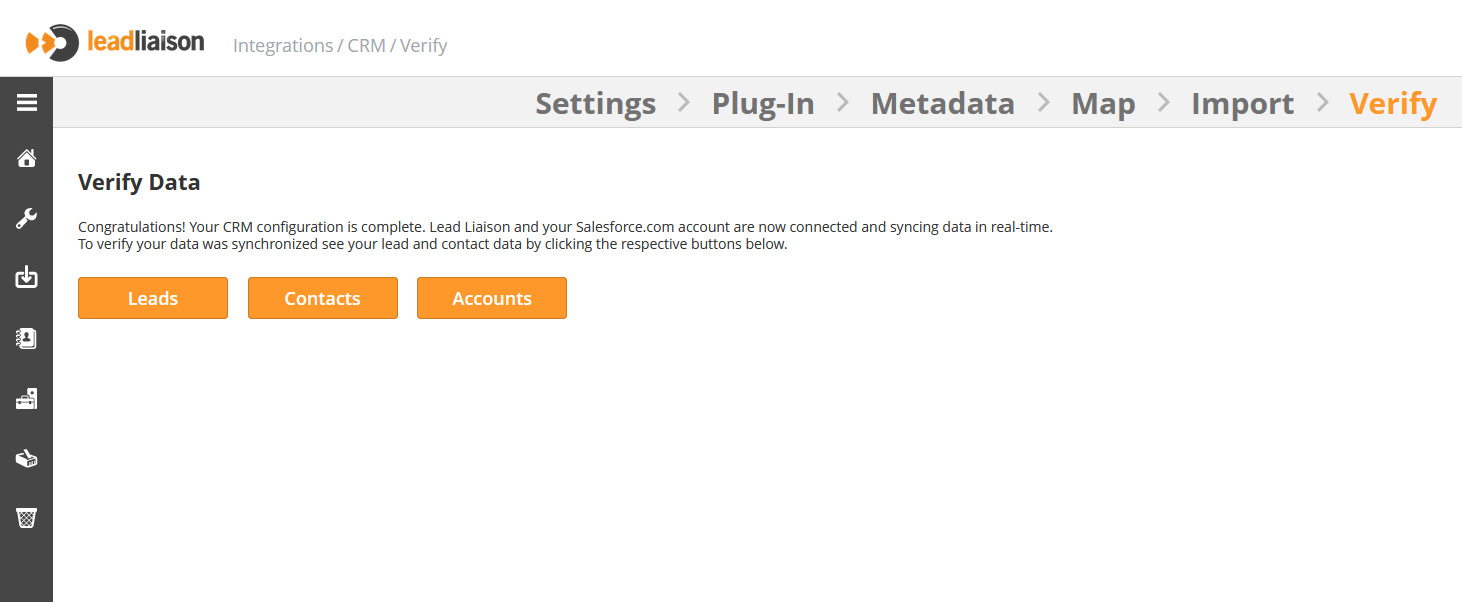...
...
...
...
...
...
...
...
...
...
...
...
...
...
...
...
...
...
...
...
...
...
...
...
...
...
...
...
...
...
...
...
...
...
...
...
...
...
...
...
...
...
...
...
...
...
...
...
...
...
...
...
...
...
...
...
...
...
...
...
...
...
...
...
...
...
...
...
...
...
...
...
...
...
...
...
...
...
...
...
...
...
...
...
...
...
...
...
...
...
...
...
...
...
...
...
...
| Info |
|---|
This document explains the steps required to connect Lead Liaison with your Salesforce.com Group Edition account. |
| Table of Contents |
|---|
Installation Overview
Lead Liaison is installed into Salesforce.com in five easy steps. Here's an overview of the installation process.
- Setup a CRM sync user by adding your CRM credentials into Lead Liaison
- Install the Lead Liaison for Salesforce.com package
- Add fields to your Lead/Contact layout in SFDC
- Create custom fields in Lead Liaison
- Configure Lead Liaison and sync your Salesforce.com data to Lead Liaison
Lead Liaison's Salesforce.com package will make the following changes to your Salesforce.com account:
...
Connecting Salesforce.com to Lead Liaison
Follow these step by step instructions to connect your Salesforce.com account to Lead Liaison.
Step 1: Add CRM Sync User
Lead Liaison requires one Salesforce.com user account be used as a sync account. The sync account is the account used to send data bidirectional, from Salesforce.com to Lead Liaison and from Lead Liaison to Salesforce.com. The sync account is required for operation and has no material impact on leads, contacts, opportunities or any other event.
| Note |
|---|
Salesforce.com suggests updating passwords every 90 days. If credentials for the sync account expire then syncing between Lead Liaison and Salesforce.com will fail. We suggest using a Salesforce.com Admin user as the sync account to use with Lead Liaison. See the section below called "Salesforce.com Admin user as the sync account to use with Lead Liaison. See the section below called "Salesforce.com Password Profiles" for tips on how to set the password to never expire on your Salesforce.com user account. |
Follow these steps below to enter your CRM sync user:
- Login to Lead Liaison at https://app.leadliaison.com/login.php (use the account you'd like to use as your sync user (usually Lead Liaison Admin)
- Go to Settings > Connectors
- Under the CRM section enter your Salesforce.com credentials. Your password is your CRM password followed by your security token. See this post on Salesforce.com for help finding your security token.
If you try to connect Salesforce.com to Lead Liaison without entering in a sync user by going to Settings > Administration > CRM you'll see a prompt like the one below. Click the 'here' link to enter in a sync user.
Once you've connected your Lead Liaison account to your Salesforce.com account successfully you'll see a success prompt like this:
Step 2: Install and Configure Salesforce.com Plugin
Install URL
Lead Liaison's Salesforce.com plugin is live on Salesforce's AppExchange portal. Access the plugin here: http://appexchange.salesforce.com/listingDetail?listingId=a0N30000009vFlTEAU
| Info | ||
|---|---|---|
| ||
Obtain the package password from your Lead Liaison Revenue Performance Specialist. |
- To view the package contents at a later point show all installed package contents under Setup > Develop > Installed Packages
Step 3: Add Lead Liaison's custom fields/sections to your SFDC layout
- Open the Leads page layout by going to 'Setup' > 'Customize' > 'Leads' > 'Page Layout'.
- Click the 'Edit' link next to the Salesforce.com layout you'd like to add Lead Liaison's custom fields/secions to.
- You will see a page similar to the one below.
- Drag the "Section" box from the tools bar, and drop it into the page below in the location you desire.
- In the popup enter "Lead Liaison Marketing Data" as the "Section Name". Leave "Layout" and "Tab-key Order" with the default settings unless you need to change them.
- Start dragging and dropping Lead Liaison's custom fields to the newly created "Lead Liaison Marketing Data" section.
- Keep going until you've added all of the following fields (15 in total):
- Lead Liaison Score
- Total Activity
- Total Web Visits
- Total Time Spent on Last Visit
- Last Sync to Lead Liaison Web App
- Last Web Visit
- Last Search Engine
- Last Search Phrase
- Original Referral Source
- Bounced
- Email Opt Out
- Lead Liaison Grade
- Lead Liaison Campaign
- Lead Liaison Program
- Profile ID
- When your section looks like the "Lead Liaison Marketing Data" section in the screen shot below click the 'Save' button to finish.
- Repeat the process of adding the new fields to your Lead Page Layout for the Contact Page Layout.
- Next, install the "Lead Liaison" section into your Lead and Contact Layout. This is a Visualforce page customized for Salesforce.com.
- Follow the screen shots below to repeat the process for both your Lead and Contact Layout.
- Set the following section properties:
- Click the settings icon (wrench) in the top-right of the Visualforge page (blue section)
- Set the Page Properties as follows:
Step 4: Map Lead Custom Fields to Contact Custom Fields
Next, map the custom fields added by the Lead Liaison plug-in. Mapping custom fields ensures information added to a Lead is transferred to a Contact when the lead is converted in Salesforce.com. To map fields do the following:
- Go to 'Setup' > 'Customize' > 'Leads' > 'Fields'.
- Scroll to the bottom and click the "Map Lead Fields" button in the "Lead Custom Fields & Relationships" section.
- Map each custom Lead field to the related Contact field. Your results should look similar to the image below:
| Note | ||
|---|---|---|
| ||
Make sure to map all the custom fields added by Lead Liaison package (Lead Liaison Score, Total Activity, Total Web Visits, Total time spent on last visit, Last Sync to Lead Liaison Web App, Last Web Visit, Last Search Engine, Last Search Phrase, Original Referral Source, Bounced and Profile Identifier) |
| Info | ||
|---|---|---|
| ||
Map only the "Profile Identifier" field. Do not map the "Profile ID" field. Lead Liaison adds the Profile Identifier field automatically. This field is a formula that builds the hyperlink for the Profile ID. By mapping the Profile Identifier Salesforce.com will automatically map the Profile ID value for you. |
Step 5: Create Custom Fields in Lead Liaison
| Note | ||
|---|---|---|
| ||
It's not necessary to create an equivalent custom field in Lead Liaison for each and every custom field in Salesforce.com. Create custom fields in Lead Liaison only for the fields you need to use in your business processes, such as segmentation, nurturing, scoring, etc. |
To create custom fields in Lead Liaison follow these instructions.
Note, custom fields can automatically be created for you as shown in the steps below.
Step 6: Configure Lead Liaison and Sync your Salesforce.com Data to Lead Liaison
You're now done with setup inside Salesforce.com. Next, go to Lead Liaison and finalize setup from Lead Liaison's web application.
Complete Lead Liaison's CRM Configuration Wizard:
Lead Liaison synchronizes data between Lead Liaison's local database and Salesforce.com in real-time. To configure your CRM settings for Lead Liaison:
- Login to Lead Liaison at https://app.leadliaison.com/login.php
- Click Settings > Administration tab in Lead Liaison.
- Click the CRM button on the left hand menu.
- Follow the wizard step by step to get your CRM account configurations complete
| Info |
|---|
Step 1: Select Edition and Default Sync Options |
- Check the "Automatically import data for new SFDC fields (make them Active) box if you want to begin pulling in data for all new custom fields automatically. When checked, any data in a custom field created in Salesforce.com will automatically be imported into Lead Liaison even if the field is not mapped to a Lead Liaison field. If this setting is turned off new custom fields will not be marked as "Active" in Lead Liaison by default (on the field mapping pages) and the data will not be imported into Lead Liaison. The custom field could be mapped later on; however, data import will start from the time the field is mapped and made "Active" and will not import older data. You may want to uncheck this field if you have confidential information (passwords, data, keys, etc.) which you do not want to expose to Lead Liaison or your employees.
- For Enterprise and Performance Editions: Make sure to configure proper permissions for all custom fields per the permission section above. If permissions are not configured properly for a custom field correct the permissions or uncheck the "Active" column on the map fields page.
- For Group or Professional Editions: Make sure to add the new fields to your layout.
- Note, this setting is turned on by default for all new accounts.
- Click "Save" when done.
- When you see the success prompt click "Next" to Step 2, Install Plug-in
| Info |
|---|
Step 2: Install Package.com Password Profiles" for tips on how to set the password to never expire on your Salesforce.com user account. |
Follow these steps below to enter your CRM sync user:
- Login to Lead Liaison at https://app.leadliaison.com/login.php (use the account you'd like to use as your sync user (usually Lead Liaison Admin)
- Go to Settings > Connectors
- Under the CRM section enter your Salesforce.com credentials. Your password is your CRM password followed by your security token. See this post on Salesforce.com for help finding your security token.
Once you've connected your Lead Liaison account to your Salesforce.com account successfully you'll see a success prompt like this:
Step 2 (Optional): Install and Configure Salesforce.com Plugin
Install URL
Lead Liaison's Salesforce.com plugin is live on Salesforce's AppExchange portal. Access the plugin here: http://appexchange.salesforce.com/listingDetail?listingId=a0N30000009vFlTEAU
| Info | ||
|---|---|---|
| ||
Obtain the package password from your Lead Liaison Revenue Performance Specialist. |
- To view the package contents at a later point show all installed package contents under Setup > Apps > Packaging > Installed Packages
Step 3: Add Lead Liaison's custom fields/sections to your SFDC layout
- Open the Leads page layout by going to Setup > Object Manager > Lead > Page Layouts
- Click on the layout you'd like to add Lead Liaison's custom fields/sections to.
- You will see a page similar to the one below
- Drag the "Section" box from the tools bar, and drop it into the page below in the location you desire.
- In the popup enter "Lead Liaison Marketing Data" as the "Section Name". Leave "Layout" and "Tab-key Order" with the default settings unless you need to change them.
- Start dragging and dropping Lead Liaison's custom fields to the newly created "Lead Liaison Marketing Data" section.
- Keep going until you've added all of the following fields (15 in total):
- Lead Liaison Score
- Total Activity
- Total Web Visits
- Total Time Spent on Last Visit
- Last Sync to Lead Liaison Web App
- Last Web Visit
- Last Search Engine
- Last Search Phrase
- Original Referral Source
- Bounced
- Email Opt Out
- Lead Liaison Grade
- Lead Liaison Campaign
- Lead Liaison Program
- Profile ID
- When your section looks like the "Lead Liaison Marketing Data" section in the screen shot below click the 'Save' button to finish.
- Repeat the process of adding the new fields to your Lead Page Layout for the Contact Page Layout.
- Next, install the "Lead Liaison" section into your Lead and Contact Layout. This is a Visualforce page customized for Salesforce.com.
- Follow the screen shots below to repeat the process for both your Lead and Contact Layout.
- Set the following section properties:
- Click the settings icon (wrench) in the top-right of the Visualforge page (blue section)
- Set the Page Properties as follows:
Step 4: Map Lead Custom Fields to Contact Custom Fields
Next, map the custom fields added by the Lead Liaison plug-in. Mapping custom fields ensures information added to a Lead is transferred to a Contact when the lead is converted in Salesforce.com. To map fields do the following:
- Go to Setup > Object Manager > Lead > Fields and Relationships
- Click the "Map Lead Fields" button
4. Click on the "Contact" tab.
3. Map each custom Lead field to the related Contact field. Your results should look similar to the image below:
| Note | ||
|---|---|---|
| ||
Make sure to map all the custom fields added by Lead Liaison package (Lead Liaison Score, Total Activity, Total Web Visits, Total time spent on last visit, Last Sync to Lead Liaison Web App, Last Web Visit, Last Search Engine, Last Search Phrase, Original Referral Source, Bounced and Profile Identifier) |
| Info | ||
|---|---|---|
| ||
Map only the "Profile Identifier" field. Do not map the "Profile ID" field. Lead Liaison adds the Profile Identifier field automatically. This field is a formula that builds the hyperlink for the Profile ID. By mapping the Profile Identifier Salesforce.com will automatically map the Profile ID value for you. |
Step 5: Create Custom Fields in Lead Liaison
| Note | ||
|---|---|---|
| ||
It's not necessary to create an equivalent custom field in Lead Liaison for each and every custom field in Salesforce.com. Create custom fields in Lead Liaison only for the fields you need to use in your business processes, such as segmentation, nurturing, scoring, etc. |
To create custom fields in Lead Liaison follow these instructions.
Note, custom fields can automatically be created for you as shown in the steps below.
Step 6: Configure Lead Liaison and Sync your Salesforce.com Data to Lead Liaison
You're now done with setup inside Salesforce.com. Next, go to Lead Liaison and finalize setup from Lead Liaison's web application.
Complete Lead Liaison's CRM Configuration Wizard:
Lead Liaison synchronizes data between Lead Liaison's local database and Salesforce.com in real-time. To configure your CRM settings for Lead Liaison:
- Login to Lead Liaison at https://app.leadliaison.com/login.php
- Go to Settings > Integrations > CRM in Lead Liaison.
- Follow the wizard step by step to get your CRM account configurations complete
| Info |
|---|
Step 1: Select Edition and whether to automatically import data for new Salesforce.com fields |
- Check the "Automatically import data for new SFDC fields (make them Active) box if you want to begin pulling in data for all new custom fields automatically. When checked, any data in a custom field created in Salesforce.com will automatically be imported into Lead Liaison even if the field is not mapped to a Lead Liaison field. If this setting is turned off new custom fields will not be marked as "Active" in Lead Liaison by default (on the field mapping pages) and the data will not be imported into Lead Liaison. The custom field could be mapped later on; however, data import will start from the time the field is mapped and made "Active" and will not import older data. You may want to uncheck this field if you have confidential information (passwords, data, keys, etc.) which you do not want to expose to Lead Liaison or your employees.
- For Enterprise and Performance Editions: Make sure to configure proper permissions for all custom fields per the permission section above. If permissions are not configured properly for a custom field correct the permissions or uncheck the "Active" column on the map fields page.
- For Group or Professional Editions: Make sure to add the new fields to your layout.
- Note, this setting is turned on by default for all new accounts.
- Click "Save" when done.
- When you see the success prompt click "Next" to Step 2, Install Plug-in
| Info |
|---|
Step 2: Install Plug-In |
- Assuming you've installed Lead Liaison's plug-in into Salesforce.com, click "Continue" on Step 2. Your plug-in installation should be validated and you'll see a success prompt similar to the one below. Click the "Next" button and proceed to Step 3 of the wizard.
- If you see an error prompt similar to the one below then the system is trying to access a field in the Lead or Contact Layout but the system is unable to do so since the respective field is not present in the Layout. Add the field to the Layout, save the Layout and proceed. In the screen shot below, the "Number of Employees" field needs to be added to the Lead Layout.
- If you are keeping the standard Salesforce.com layout and would like Lead Liaison to automatically add our custom fields to the standard layout then the wizard will display a page similar to the one below. Check the box and click "Next" to proceed to Step 3 of the wizard.
| Warning | ||
|---|---|---|
| ||
If you see an error similar to the one below during Step 2 of the CRM configuration wizard then there's an issue with the visibility/permissions of the SFDC field. SFDC Group Edition requires all standard and custom fields to be added to the layout to be visible. Lead Liaison requires all SFDC standard and custom fields to be visible for Lead Liaison to communicate with your Group Edition instance. Add the field in question from the error prompt to your Lead/Contact layout and run Step 2 again to remove the error. |
| Info |
|---|
Step 3: Import Metadata |
- The only Salesforce.com standard field that Lead Liaison adds values to is the "Lead Source" field. By default, Lead Liaison's "Original Lead Source" field is mapped to Salesforce.com's "Lead Source" field. If you do not want Lead Liaison's Original Lead Source data to be integrated with the Lead Source field then uncheck the "Deploy Lead Liaison custom Lead Source values" checkbox. If you want to separate Salesforce.com's Lead Source and Lead Liaison's Original Lead Source values do the following:
- Create a new SFDC Lead and Contact Custom field called "Lead Liaison Lead Source"
- Create a new custom field in Lead Liaison called "SFDC Lead Source"
In Lead Liaison change the Lead and Contact field mappings:
Map the SFDC standard field "Lead Source" to the new custom field called "SFDC Lead Source" with bi-directional sync.
Map the new custom field in SFDC, "Lead Liaison Lead Source", to Lead Liaison's "Original Lead Source" field with one-way syncing from Lead Liaison to Salesforce.com.
| Info |
|---|
Step 4: Map Fields |
| Info | ||
|---|---|---|
| ||
Only create and map custom fields in Lead Liaison for the custom fields in SFDC that you plan to use. There is no need to create a Lead Liaison custom field for each SFDC custom field. For example, if you plan to use only 10 custom fields in SFDC for scoring, grading, nurturing, segmentation, distribution, etc. then create 10 custom fields in Lead Liaison. We suggest using the same name for the custom field in both Lead Liaison and Salesforce.com to make mapping easier. |
- It's possible to pull in only a subset of your CRM data by using the "Sync Criteria" section at the top of each mapping page. Filtering which CRM data to bring into and sync with Lead Liaison is helpful if you're using Lead Liaison for specific products or your license is limited to a certain amount of prospects. In the example below, we're pulling in only Saleforce.com Leads in the Finance and Software industry who are also in Texas.
- Checking the "Active" box allows data to be imported from Salesforce.com into Lead Liaison from the time the field is made Active, regardless if the field is mapped to a Lead Liaison field or not.
- Instead of manually creating new custom fields in Lead Liaison the fields can automatically be created by checking the "Create New" box next to the field.
- Note, you'll see some new SFDC fields on the left-hand side such as the ones inside the red boxes below. These SFDC fields are not Lead Liaison custom or standard fields; however, they are internal Lead Liaison fields and mapped automatically in the background. You can optionally create Lead Liaison custom fields and map this information from SFDC to Lead Liaison for any purpose.
| Info |
|---|
Step 5: Import Records |
| Info | ||
|---|---|---|
| ||
For the "Importing Data" process, Lead Liaison will start importing the SFDC records from SFDC to Lead Liaison. For each record type (Lead, Contact or Account) Lead Liaison makes only one ping to SFDC and loads a list of records to process in Lead Liaison. The default amount of imported data per request is 500, but may vary from one edition of SFDC to another. |
| Info |
|---|
Step 6 (Final Step): Verify Data |
Click on Leads, Contacts or Accounts to see a list of each of them.
Once you are done, then your CRM configurations are complete and the bi-directional sync process between Salesforce.com and Lead Liaison will work automatically.
...
System Administrators can disable password expiration in two ways:
1. For all users:
Administration Setup | Security Controls | Setup > Security > Password Policies
2. For User Profiles:
In each case, multiple users may be affected which is not recommended for security purposes. If a particular user needs to have password expiration disabled, a new profile specific for that user will need to be created:
Go to Settings > Users > Profiles and follow the steps below:
1. Open Identify the profile associated to the user that needs password expiration disabled.
2. Click on the 'Clone' button to create an identical profile to the user's current profile.
3. Once the new profile has been created, edit the profile and check the 'Password Never Expires' option under the Administrative Permissions section.
4. Save the profile.
5. Edit the user record and associate the user to the newly created profile.
In the end, the user will have the same profile as before except with the password expiration set to never expire.
Enable automatic lead creation (optional)
Lead Liaison offers the ability to automatically create a lead in Salesforce.com from visitors to your website that come from Connector (E-mail Marketing solution) or Send & Track (Microsoft Outlook Plug-in).
- Login to Lead Liaison at https://app.leadliaison.com/login.php
- Click Settings > Setup on the top of the page.
- Under "Admin Settings" section, click 'Account settings'.
- Check the check boxes next to "Auto-create CRM lead from email campaigns" and "Auto-create CRM lead from Send & Track emails" to enable automatic lead creation.
Setting up additional users
Have each user add their CRM credentials inside Lead Liaison. Provide instructions to your users to add their CRM credentials. Adding their CRM credentials allows the Lead Liaison user to:
...
3. Once the new profile has been created, edit the profile and check the 'Password Never Expires' option under the Administrative Permissions section.
4. Save the profile.
5. Edit the user record and associate the user to the newly created profile.
In the end, the user will have the same profile as before except with the password expiration set to never expire.
Enable automatic lead creation (optional)
Lead Liaison offers the ability to automatically create a lead in Salesforce.com from visitors to your website that come from Connector (E-mail Marketing solution) or Send & Track (Microsoft Outlook Plug-in).
- Login to Lead Liaison at https://app.leadliaison.com/login.php
- Click Setupon the top right of the page.
- Navigate to Account > Settings from the left side.
- Turn on the switch next to "Auto-create CRM lead from email campaigns" and "Auto-create CRM lead from Send & Track emails" to enable automatic lead creation.
| Tip |
|---|
Congratulations, you're done! |
Removing Fields
Removing SFDC Custom Fields
...
Removing the Lead Liaison Package
- First, remove all dependencies. Dependencies must be removed first before uninstalling. For example, assigning the Lead Liaison Lead Layout to a profile is a dependency. Change the layout profile to another profile or the standard profile first.
- Inside Salesforce.com go to 'Setup' > 'View > Apps > Packaging > Installed Packages'. If there are any dependencies removal will fail.

